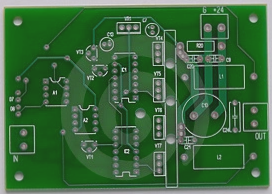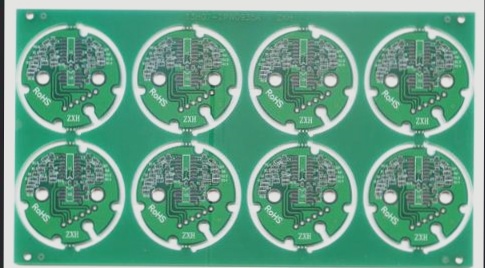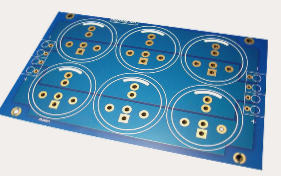1: During PCB layout, ensure that the input and output traces of the filter circuit, as well as isolation and protection circuits, do not couple with each other.
**Reason**: When the input and output traces of these circuits are coupled, the effectiveness of the filtering, isolation, or protection is compromised.
2: If a “clean ground” interface is designed on the board, place the filtering and isolation components on the isolation strip between the “clean ground” and the working ground.
**Reason**: This prevents coupling between filtering or isolation components through the ground plane, which could weaken their effectiveness.
3: On the “clean ground,” only filtering and protection components should be placed—no other devices.
**Reason**: The primary purpose of the “clean ground” design is to minimize interface radiation, and since the “clean ground” is more susceptible to external interference, it should not contain irrelevant circuits or components.
4: Components that generate strong radiation, such as crystals, crystal oscillators, relays, and switching power supplies, should be positioned at least 1000 mils away from the board’s interface connectors.
**Reason**: These components can radiate interference directly, or the current they generate may be coupled into the outgoing cables, causing radiation.
5: Sensitive circuits or components (such as reset circuits, watchdog circuits, etc.) should be placed no less than 1000 mils away from any edge of the board, especially near the interface edge.
**Reason**: Board edges, particularly around interface areas, are most vulnerable to external interference (e.g., electrostatic discharge), and sensitive circuits like resets or watchdogs are prone to malfunction in these environments.
6: Filter capacitors for IC power supply filtering should be positioned as close as possible to the power supply pins of the chip.
**Reason**: The shorter the distance between the capacitor and the power pin, the smaller the high-frequency loop area, which helps reduce radiation.
7: The series termination resistor at the signal start or end should be placed close to the signal output pin.
**Reason**: The purpose of the series termination resistor is to match the output impedance of the chip to the characteristic impedance of the trace. Placing it at the signal output end ensures proper impedance matching.
8: PCB traces should not have sharp angles, such as right angles or acute angles.
**Reason**: Right-angle traces cause impedance discontinuities, which can lead to signal integrity issues like ringing, overshoot, and increased EMI radiation.
9: Avoid adjacent signal traces on different layers whenever possible. If unavoidable, ensure that traces on the two layers are perpendicular to each other, or that the parallel trace length is kept under 1000 mils.
**Reason**: This reduces crosstalk between parallel traces and minimizes interference.

10: If the board includes an internal signal layer, critical signal traces such as clocks should be routed on the inner layer (the preferred signal layer should be selected).
Reason: Routing critical signals on an internal layer helps provide shielding.
11: It is recommended to route ground traces on both sides of the clock line, with grounding points spaced no more than 3000mil apart.
Reason: This ensures that all points on the package’s ground line maintain equal potential.
12: Key signal traces such as clocks, buses, radio frequency lines, and other parallel traces on the same layer should adhere to the 3W principle.
Reason: This minimizes the risk of crosstalk between signals.
13: The pads of surface-mount components like fuses, magnetic beads, inductors, and tantalum capacitors used for power supplies with currents ≥ 1A should each have at least two vias connecting to the ground plane.
Reason: This reduces the via’s equivalent impedance.
14: Differential signal pairs should be placed on the same layer, kept equal in length, and routed parallel to each other without any other traces in between.
Reason: This ensures consistent impedance and enhances the pair’s resistance to interference.
15: Critical signal traces must not cross areas where the reference plane is split (including gaps caused by vias and pads).
Reason: Crossing these areas increases the loop area of the signal, potentially causing performance issues.
16: If dividing the signal line across its return plane is unavoidable, it is recommended to use a bridge capacitor (1nF) near the signal’s return plane split.
Reason: This method helps mitigate the increased loop area by artificially creating a signal return path.
17: Avoid running irrelevant signal traces under the filter circuitry on the board.
Reason: Distributed capacitance can degrade the effectiveness of the filter.
18: The input and output traces of a filter should not run in parallel or cross each other.
Reason: This prevents direct noise coupling between signals before and after filtering.
19: The distance between critical signal traces and the edge of the reference plane should be ≥ 3H (where H is the trace height above the reference plane).
Reason: This helps reduce the effects of edge radiation.
20: For components with metal shells, ground copper should be placed on the top layer in the area where the metal shell projects.
Reason: This uses the distributed capacitance between the metal shell and ground copper to suppress external radiation and improve immunity.
21: In single-layer or double-layer boards, special attention should be paid to minimizing the loop area when routing.
Reason: Smaller loop areas result in lower external radiation and stronger resistance to interference.
22: When a signal line (especially a critical signal line) transitions between layers, a ground via should be placed near the layer transition via.
Reason: This reduces the area of the signal loop.
23: Strong radiation signal lines such as clock lines, buses, and RF lines should be kept away from interface signal lines.
Reason: This prevents interference from high-radiation signals from coupling with outgoing signals and radiating externally.
24: Sensitive signal lines such as reset, chip select, and system control signals should be positioned away from interface and outgoing signal lines.
Reason: Interface signal lines are prone to external interference, which could couple into sensitive signals and cause system malfunctions.
25: On single- or double-sided PCBs, the routing of the filter capacitor should begin from the capacitor and go directly to the device pins.
Reason: This ensures the power supply voltage is filtered before reaching the IC, while any noise generated by the IC is also filtered out by the capacitor.
26: In single- or double-sided PCBs, if the power line is long, decoupling capacitors should be placed every 3000mil, with a capacitance of 10uF + 1000pF.
Reason: This helps filter high-frequency noise on the power line.
27: The ground and power traces connected to the filter capacitor should be as short and thick as possible.
Reason: Short, thick traces minimize equivalent series inductance, which would otherwise lower the capacitor’s resonant frequency and reduce its high-frequency filtering effectiveness.
If you have any PCB manufacturing needs, please do not hesitate to contact me.Contact me
**Reason**: When the input and output traces of these circuits are coupled, the effectiveness of the filtering, isolation, or protection is compromised.
2: If a “clean ground” interface is designed on the board, place the filtering and isolation components on the isolation strip between the “clean ground” and the working ground.
**Reason**: This prevents coupling between filtering or isolation components through the ground plane, which could weaken their effectiveness.
3: On the “clean ground,” only filtering and protection components should be placed—no other devices.
**Reason**: The primary purpose of the “clean ground” design is to minimize interface radiation, and since the “clean ground” is more susceptible to external interference, it should not contain irrelevant circuits or components.
4: Components that generate strong radiation, such as crystals, crystal oscillators, relays, and switching power supplies, should be positioned at least 1000 mils away from the board’s interface connectors.
**Reason**: These components can radiate interference directly, or the current they generate may be coupled into the outgoing cables, causing radiation.
5: Sensitive circuits or components (such as reset circuits, watchdog circuits, etc.) should be placed no less than 1000 mils away from any edge of the board, especially near the interface edge.
**Reason**: Board edges, particularly around interface areas, are most vulnerable to external interference (e.g., electrostatic discharge), and sensitive circuits like resets or watchdogs are prone to malfunction in these environments.
6: Filter capacitors for IC power supply filtering should be positioned as close as possible to the power supply pins of the chip.
**Reason**: The shorter the distance between the capacitor and the power pin, the smaller the high-frequency loop area, which helps reduce radiation.
7: The series termination resistor at the signal start or end should be placed close to the signal output pin.
**Reason**: The purpose of the series termination resistor is to match the output impedance of the chip to the characteristic impedance of the trace. Placing it at the signal output end ensures proper impedance matching.
8: PCB traces should not have sharp angles, such as right angles or acute angles.
**Reason**: Right-angle traces cause impedance discontinuities, which can lead to signal integrity issues like ringing, overshoot, and increased EMI radiation.
9: Avoid adjacent signal traces on different layers whenever possible. If unavoidable, ensure that traces on the two layers are perpendicular to each other, or that the parallel trace length is kept under 1000 mils.
**Reason**: This reduces crosstalk between parallel traces and minimizes interference.

10: If the board includes an internal signal layer, critical signal traces such as clocks should be routed on the inner layer (the preferred signal layer should be selected).
Reason: Routing critical signals on an internal layer helps provide shielding.
11: It is recommended to route ground traces on both sides of the clock line, with grounding points spaced no more than 3000mil apart.
Reason: This ensures that all points on the package’s ground line maintain equal potential.
12: Key signal traces such as clocks, buses, radio frequency lines, and other parallel traces on the same layer should adhere to the 3W principle.
Reason: This minimizes the risk of crosstalk between signals.
13: The pads of surface-mount components like fuses, magnetic beads, inductors, and tantalum capacitors used for power supplies with currents ≥ 1A should each have at least two vias connecting to the ground plane.
Reason: This reduces the via’s equivalent impedance.
14: Differential signal pairs should be placed on the same layer, kept equal in length, and routed parallel to each other without any other traces in between.
Reason: This ensures consistent impedance and enhances the pair’s resistance to interference.
15: Critical signal traces must not cross areas where the reference plane is split (including gaps caused by vias and pads).
Reason: Crossing these areas increases the loop area of the signal, potentially causing performance issues.
16: If dividing the signal line across its return plane is unavoidable, it is recommended to use a bridge capacitor (1nF) near the signal’s return plane split.
Reason: This method helps mitigate the increased loop area by artificially creating a signal return path.
17: Avoid running irrelevant signal traces under the filter circuitry on the board.
Reason: Distributed capacitance can degrade the effectiveness of the filter.
18: The input and output traces of a filter should not run in parallel or cross each other.
Reason: This prevents direct noise coupling between signals before and after filtering.
19: The distance between critical signal traces and the edge of the reference plane should be ≥ 3H (where H is the trace height above the reference plane).
Reason: This helps reduce the effects of edge radiation.
20: For components with metal shells, ground copper should be placed on the top layer in the area where the metal shell projects.
Reason: This uses the distributed capacitance between the metal shell and ground copper to suppress external radiation and improve immunity.
21: In single-layer or double-layer boards, special attention should be paid to minimizing the loop area when routing.
Reason: Smaller loop areas result in lower external radiation and stronger resistance to interference.
22: When a signal line (especially a critical signal line) transitions between layers, a ground via should be placed near the layer transition via.
Reason: This reduces the area of the signal loop.
23: Strong radiation signal lines such as clock lines, buses, and RF lines should be kept away from interface signal lines.
Reason: This prevents interference from high-radiation signals from coupling with outgoing signals and radiating externally.
24: Sensitive signal lines such as reset, chip select, and system control signals should be positioned away from interface and outgoing signal lines.
Reason: Interface signal lines are prone to external interference, which could couple into sensitive signals and cause system malfunctions.
25: On single- or double-sided PCBs, the routing of the filter capacitor should begin from the capacitor and go directly to the device pins.
Reason: This ensures the power supply voltage is filtered before reaching the IC, while any noise generated by the IC is also filtered out by the capacitor.
26: In single- or double-sided PCBs, if the power line is long, decoupling capacitors should be placed every 3000mil, with a capacitance of 10uF + 1000pF.
Reason: This helps filter high-frequency noise on the power line.
27: The ground and power traces connected to the filter capacitor should be as short and thick as possible.
Reason: Short, thick traces minimize equivalent series inductance, which would otherwise lower the capacitor’s resonant frequency and reduce its high-frequency filtering effectiveness.
If you have any PCB manufacturing needs, please do not hesitate to contact me.Contact me




